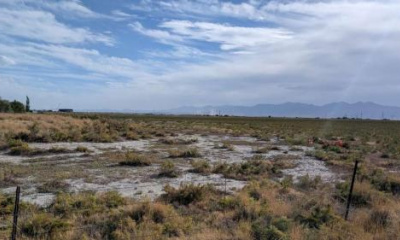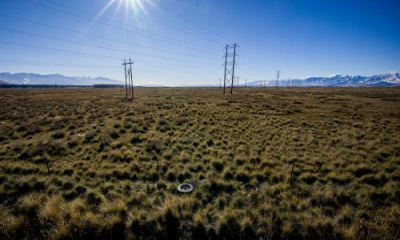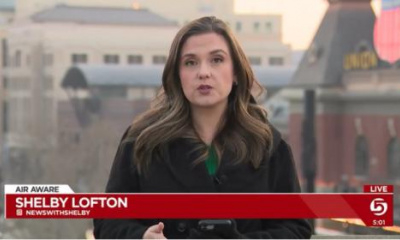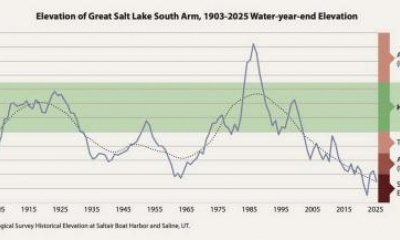SALT LAKE CITY — A major new report prepared for Utah political leaders by state agencies and research universities concludes that "no single solution" will cure the Great Salt Lake's woes, but recommends a series of measures to prevent an ecological catastrophe.
The report, released Wednesday, was conducted by the "Great Salt Lake Strike Team." It's made up of state natural resources agencies and researchers from Utah State University and the University of Utah. It is separate from a report prepared by the newly-appointed Great Salt Lake Commissioner who made similar recommendations to policymakers.
"The 2023 water year contributed a significant amount of water to the Great Salt Lake Basin. Paired with emergency measures like raising the adaptive management berm, the daily elevation of the south arm of the lake rose 5.5 feet. Evaporation reduced 2023 water gains by 2.0 feet, resulting in a net elevation increase of 3.5 feet," the strike team's report said.
There is a lot of positive news in the strike team's report. Even though this winter doesn't offer the same amount of snowpack (recent storms notwithstanding), Utah's reservoirs are fuller now than previous years. Groundwater levels are also higher. That means any water that does come in is more likely to go downstream and into the Great Salt Lake. The salinity of the Great Salt Lake is also more healthy because of higher inflows and raising the berm between the north and south arms of the lake.
When it comes to human water use, things are also looking steady. Agriculture still remains the top water user in Utah, but it remains "relatively constant" since 1989, the report said. Not surprisingly with Utah's growth, municipal and industrial use of water has increased over the same time period. Water use tied to the Great Salt Lake's lucrative mineral extraction industries has actually decreased since 2007, the report said.
But trends are not good.
"Cutting-edge climate models project that over the long term, expected increases in precipitation will be overwhelmed by rising temperature and evaporation, creating further challenges for the lake," the report said.
The Great Salt Lake dropped to its lowest levels in recorded history in 2022. It is a result of water diversion, drought and a changing climate.
"The biggest part by far however is human water use and human water diversion. That’s an opportunity because that tells us the future of lake levels is largely in our hands," said Dr. William Anderegg of the University of Utah's Wilkes Center for Climate Science and Policy, who co-chairs the strike force.
It has alarmed the public and policymakers alike because of the environmental crisis it presents that impacts public health, wildlife and the economy. There's naturally-occurring toxins in the exposed lake bed (and windy days blow that dust into populated areas along the Wasatch Front); reduced snowpack that impacts everything from water supply to the ski industry; and impacts to public health and critical wildlands. The Great Salt Lake is a critical refuge for millions of migratory birds.
Utah leaders have worked to reverse its declines, passing a series of bills and spending over $1 billion on water conservation measures. But politicians have faced a lot of criticism from the public that not enough is being done to save the lake.
On Wednesday, a coalition of health care workers sent a letter to the Utah State Legislature urging more action.
"Almost 400 physicians and some other medical professionals to send a dire plea to the state legislature to do more to save Great Salt Lake," said Dr. Courtney Henley with Utah Physicians for a Healthy Environment.
Dr. Henley said she had hope political leaders would do more, but she worried it would not be quickly enough to avoid health impacts from toxic dust.
Environmental groups are suing Utah for not taking drastic enough measures to ensure the Great Salt Lake gets water. Many of them are planning a public rally on Jan. 20 at the Utah State Capitol to pressure elected leaders to do more. On Wednesday, dozens of people showed up to the Capitol to protest maneuvers by Utah political leaders to expand sites for the inland port project (a series of import-export centers designed to get goods through the state), which they say are encroaching too close to critical wetland habitats along the Great Salt Lake.
"The state is choosing to engage in this industrial development on the shores of Great Salt Lake that will destroy up to 50,000 acres of wetlands," Deeda Seed with the Center for Biological Diversity told FOX 13 News.
FOX 13 News recently reported on some legislation to be introduced in the upcoming session of the Utah State Legislature that would address some of the solutions identified in Wednesday's strike team report. For example, "water shepherding," which ensures that water that is conserved actually gets to the Great Salt Lake. Another piece of legislation would pay agriculture producers for water they don't use to go downstream into the lake.
"Water conservation efforts are ineffective for Great Salt Lake if that conserved water does not reach it. Established efforts must be augmented to make residential, business, and agricultural conservation meaningful solutions," the strike team's report said.
That has been a problem. A recent investigation by the Great Salt Lake Collaborative (of which FOX 13 News is a member) found that while Utah lawmakers have spent hundreds of millions of taxpayer dollars to get farmers and ranchers to switch to water-saving technologies that will help with water conservation, the state of Utah can't track whether that saved water is actually getting to the lake. An audit prepared for legislators also backed up that reporting.
Another recommendation in Wednesday's report? Better measurement systems and setting a "healthy range" of a lake level to work toward (something the legislature rejected in last year's legislative session).
"Restoring Great Salt Lake to a healthy range involves filling the lake to a healthy level and then maintaining that level. The Division of Forestry, Fire and State Lands has created an elevation matrix that shows healthy ranges for a variety of competing interests. The Strike Team has made estimates as an aid to decision-makers of the inflow volume required to fill and maintain the lake at an elevation of 4,198 over four different time periods," the report said.
On Wednesday morning, the Great Salt Lake level as measured at the marina near Saltair was 4,193 feet.
Earlier this week, House Speaker Mike Schultz, R-Hooper, vowed they would not give up on the Great Salt Lake.
"I'm very passionate about the Great Salt Lake," he said in response to a question from an audience member at an event put on by the Utah Taxpayers Association. Speaker Schultz advocated for solutions to get more water into the lake and further conservation.
"We need to continue to work, put policies in place," he told the crowd. "The Great Salt Lake? We will not let it dry up."








